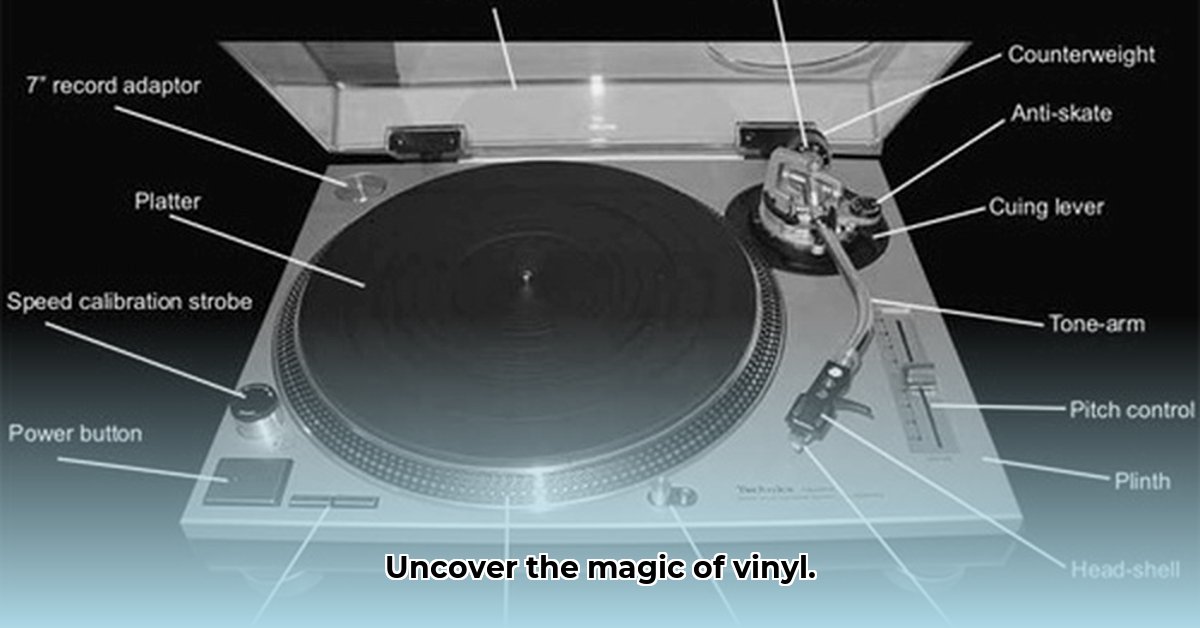From Edison’s groundbreaking invention to its modern resurgence, the vinyl record has captivated music lovers for generations. This comprehensive guide explores the intricacies of vinyl technology, guiding you through every step of the process, from the initial recording to the final playback on your turntable. Uncover the magic behind the warm, rich sound that defines the analog experience.
The Vinyl Record: A Symphony in Grooves
Vinyl records, crafted from polyvinyl chloride (PVC), store audio information in the form of microscopic grooves. These grooves spiral inwards from the outer edge, carrying the sonic blueprint of the music. Examining a record under a microscope reveals intricate etchings on either side of each groove. These subtle variations, when traced by a stylus, recreate the original sound waves. The length of the groove on a standard LP can exceed 1,400 feet, a testament to the intricate detail embedded within. Different record sizes and speeds (7″, 10″, 12″ at speeds like 33 1/3, 45, and 78 RPM) accommodate varying recording lengths and audio formats. Understanding these variations is crucial for proper playback and appreciating the diverse world of vinyl.
From Studio to Pressing Plant: The Birth of a Vinyl Record
The journey of a vinyl record begins in the recording studio. Microphones capture sound waves, converting them into electrical signals. These signals are then meticulously mixed and mastered by a sound engineer, preparing them for the intricate process of lacquer cutting. A specialized lathe, equipped with a precision cutting stylus, etches the audio signal onto a lacquer-coated aluminum disc. This master disc serves as the foundation for the subsequent stages of production. From the master lacquer, a series of metal stampers are created. These stampers, the inverse image of the master, are used in the final pressing stage. Heated PVC “biscuits” are placed between the stampers in a hydraulic press, where immense pressure and heat mold the vinyl into the final record, complete with grooves and labels. This meticulous process transforms raw materials into the tangible embodiment of musical artistry.
The Record Player: Decoding the Analog Message
The record player, often synonymously referred to as a turntable, is the instrument that brings the vinyl record to life. Its core components work in harmony to transform the physical grooves into audible sound. The turntable platter, driven by a motor (either belt-driven for quieter operation or direct-driven for precise speed control), spins the record at a precise speed. As the record spins, the tonearm, a delicately balanced lever, lowers the stylus onto the grooves.
The stylus, typically crafted from diamond or sapphire, navigates the intricate contours of the grooves. Its vibrations, mirroring the encoded sound waves, are transmitted to the cartridge. The cartridge houses magnets and coils that convert the mechanical energy of the stylus movements into electrical signals. These minute signals, carrying the musical essence, then travel through the tonearm to the phono preamp. The phono preamp amplifies the weak signal, preparing it for the main amplifier, which further boosts the signal to drive the speakers. This intricate chain reaction transforms the physical information stored within the grooves into the music we hear.
Setting Up Your System for Optimal Playback
A properly configured setup is crucial for maximizing your vinyl listening experience. Begin by ensuring your turntable is perfectly level, using a spirit level to achieve precise placement. Connect the turntable to a phono preamp (either built-in or external), then to the main amplifier, and finally to the speakers. Adjust the tracking force, the downward pressure of the stylus on the record, according to your cartridge’s specifications. Proper tracking force ensures accurate tracking and minimizes record wear. Set the anti-skate mechanism to counteract the inward pull of the stylus, maintaining balanced tracking across the record’s surface.
Maintenance and Troubleshooting: Preserving Your Analog Investment
Regular maintenance is essential for preserving your vinyl collection and ensuring optimal performance. Clean your records before each play using a carbon fiber brush and a specialized cleaning solution to remove dust and debris. Store your records vertically in anti-static sleeves, away from direct sunlight and heat, to prevent warping and damage. Handle records carefully, avoiding contact with the playing surface. Clean your stylus regularly using a stylus brush to remove accumulated dust and debris.
Common playback issues such as silence, distortion, or skipping can often be resolved with simple troubleshooting steps. Check all connections to ensure proper signal flow. Adjust the tracking force or replace the stylus if distortion persists. Clean the record or replace the stylus if skipping occurs. Regular maintenance and prompt troubleshooting will ensure years of uninterrupted enjoyment from your vinyl setup.
Choosing the Right Components: A Personalized Listening Experience
Selecting the right cartridge and amplifier significantly impacts the overall sound quality. Moving Magnet (MM) cartridges are generally more affordable and user-friendly, while Moving Coil (MC) cartridges offer higher fidelity but require more specialized equipment. Choose the cartridge type that aligns with your budget and listening preferences. Different stylus shapes, such as spherical, elliptical, and Shibata, influence both sound quality and record wear. Research the various stylus profiles to find the optimal balance between detail retrieval and longevity.
Amplifiers, the driving force behind your sound system, come in two main varieties: tube and solid-state. Tube amplifiers are known for their warm, rich sound, while solid-state amplifiers offer a cleaner, more precise output. Select the amplifier type that complements your musical taste and desired sonic characteristics. By carefully considering these component choices, you can curate a personalized vinyl experience that truly reflects your individual preferences.
By understanding the technology behind vinyl records and record players, and by following the setup, maintenance, and troubleshooting tips outlined in this guide, you can unlock the full potential of analog sound and immerse yourself in the timeless magic of vinyl.










